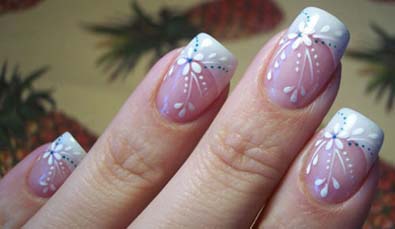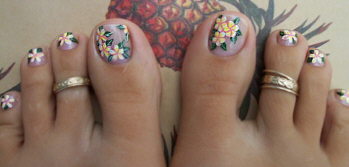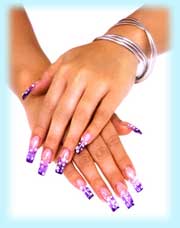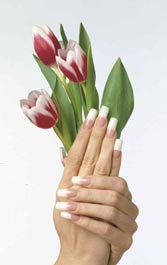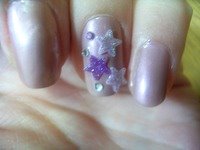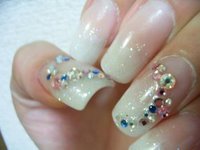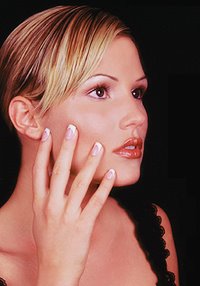
Woman who gets fake nails could be getting something else in the bargain - a dangerous dose of poison.
A toxin eradicated from the beauty industry 25 years ago has made a quiet comeback in nail salons nationwide, including New York - and nobody's doing anything for stopping it.
Methyl methacrylate (MMA) can rip nails off fingers, cause nerve problems and severe rashes - and over the long term hurt kidneys, livers fetuses and livers.
"It's being sold openly. You can buy it all over the place," said California beauty-industry chemist Douglas Schoon, who studied the problem.
MMA is found mostly at discount salons because it costs $20 to $60 a gallon, compared to about $200 for top-of-the-line, safer products.
Manicurists combine liquid MMA with a powder to build so-called sculptured, or acrylic, nails. It is also sometimes used in acrylic "wraps" of artificial nail tips.
The super-cheap chemical isn't supposed to be used by manicurists.
But Post reporters easily bought MMA products from two Queens beauty-supply stores - and during a random check of 13 nail salons found the toxin in two of them. Two wouldn't say what they used, and two more didn't know.
Employees at both supply stores said they had no idea MMA shouldn't be used on nails.
Almost no information about the acrylic is available in Korean or Vietnamese - two groups that have cornered the cut-rate salon market.
Competition is so tough, some salon owners get the cheapest product they can find, said Michael Limb, head of the Asian American Advisory Council and member of the state board that licenses manicurists.
"Everybody's got it. Everybody's selling it," said Kevin Bae, a salesman at Hi-Fashion Beauty Supplies in Sunnyside, Queens, one store where The Post bought the chemical.
"If they tell us not to sell it, we'll follow the law," he said.
Federal Food and Drug Administration officials ruled in the early 1970s that MMA is poisonous when used on nails.
The agency seized products - a move that held up in court and effectively killed the market. But the FDA never actually banned it.
"The use seems to be coming back," said Dr. John Bailey, head of the FDA's Office of Cosmetics and Colors. "Our position is still that it's unsafe."
In some people, MMA causes a poison-ivy-like rash and in extremely rare cases causes permanent damage, say Manhattan nail specialists.
The super-glue chemical bonds so strongly to the natural nail that it can rip the nail right off if it's accidentally bumped, Schoon said.
Workers who breathe MMA for years can suffer kidney and liver lesions, reproductive problems and possibly lung and cardiovascular damage, according to the federal Environmental Protection Agency.
The chemical is manufactured by a handful of mega-corporations that sell it legally to the construction- and dental-supply companies - who are probably diverting it to the beauty industry, Bailey said.
The FDA lacks the manpower to launch a full-blown investigation, he said.
The state, which licenses manicurists and regulates salons, has no rules about its use - although the Health Department is "reviewing" the issue, a spokeswoman said.
Without tight federal or state control, MMA is flourishing again.
When a Post reporter was shopping for acrylic liquids in Queens, a Bronx manicurist whispered she would sell the reporter a gallon for just $35. It turned out to be MMA.

























 The manicure executed up to the mark - not less important accessory in the celebratory order, than a handbag or a scarf. That nails became your true ornament, masters of manicure advise to consider any trifle: length of clothes, height of a heel, is shorter - all your style.
The manicure executed up to the mark - not less important accessory in the celebratory order, than a handbag or a scarf. That nails became your true ornament, masters of manicure advise to consider any trifle: length of clothes, height of a heel, is shorter - all your style.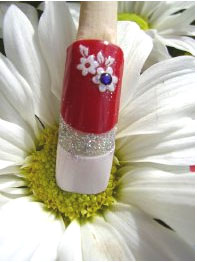 Being classics of a genre, it constantly varies and changes depending on solemnity of event and even a season. Variant for a party - the French manicure with spangle. Will approach for a holiday and a marble french manicure (one more name of the French manicure) where tips of nails are formed of acryle or gel of different colors. The French manicure "Chameleon" approaches girls who love changes. The edge of a nail is modelled from transparent gel or acryle, and from a underside becomes covered by a varnish-chameleon.
Being classics of a genre, it constantly varies and changes depending on solemnity of event and even a season. Variant for a party - the French manicure with spangle. Will approach for a holiday and a marble french manicure (one more name of the French manicure) where tips of nails are formed of acryle or gel of different colors. The French manicure "Chameleon" approaches girls who love changes. The edge of a nail is modelled from transparent gel or acryle, and from a underside becomes covered by a varnish-chameleon.  Nails will please you with the novelty because colors can be changed though every day.
Nails will please you with the novelty because colors can be changed though every day.

